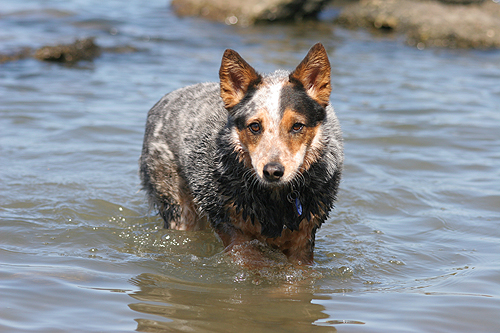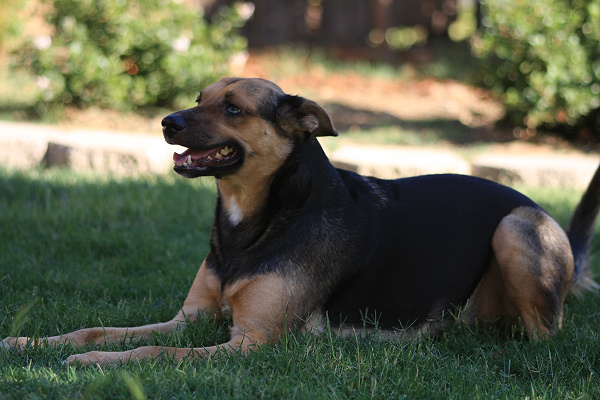A few years ago, I noticed a couple outside a coffee shop allowing two unknown dogs to greet on leash, nose to nose. This is what the two dogs looked like:
- Standing up on tippy-toes
- Stiff body posture
- Ears pulled forward
- Hackles up on both dogs
- Tails flagging (waving fast, with one dog who had a still lower tail and a fast moving tip) with tail arched as high over back as physically possible (both dogs were 20lb mixed breeds).
Both were about the same size, height and body structure. I noticed that the dog closest to me appeared ready to take on the other dog, he was leaning forward more so than the other dog, was a lot more tense. Because dog fights are scary, nasty things, even if they last for three seconds, I tried to politely tell the couple they might want to distract their dogs, to avoid a fight.
Oh, but they're wagging their tails. They're just happily greeting each other!
Plus they gave me nasty looks as if I was trying to disrupt the order of things. No sooner had I shrugged my shoulders and was about to walk past them, the dog closest to me had had enough of the staring contest. He launched his teeth into the other dog. Screaming ensued, chaos! horror! END OF THE WORLD! Both owners tugged at the leashes, separating the dogs to check them over. No bite wounds, no punctures. I am always amazed at how, more often than not, dog fights are more about finding ways to shove and push and convey messages without doing bodily harm. I've seen more damage on my dogs after an intense play-wrestle bout.
It highlights how even people with dogs can be insensitive or ignorant of the signals their dogs are trying to convey. We mess things up majorly. We ignore subtle cues, goggle at overt cues as if they came out of nowhere, and we blithely confuse play behaviors with aggressive behaviors with fear behaviors. What I've wondered is what kinds of behaviors do people, both dog-savvy and dog-ignorant, easily comprehend and what behaviors do people constantly confuse.
Recently, researchers from Italy and the UK published a study in Applied Animal Behaviour Science entitled "Description of the behavior of domestic dog (Canis familiaris) by experienced and inexperienced people". This is, by no means, the end-all study on how people perceive dog behavior. It is a jumping point for further research, and the discussion includes all the ways in which this study could be improved upon or if there were possible issues with the results provided.
Regardless, the results are interesting.
The study involved nine taped video sequences between two dogs. Eight dogs* were filmed during their first contact with a "stooge dog", a mid-age female Border Collie. She was, for all intents and purposes, the "control" dog, although she was used as the "focal" dog in one interaction. The focal dog was always kept stationary, on leash, as the stooge dog approached. Filming occurred in public parks and time of taping started 10 seconds before the Border Collie entered the camera's frame until the end of the interaction. For the safety of the dogs and owners, aggressive contact interactions (as predicted by the experimenters) were not permitted. Unfortunately, no video was available, which would make reading this study a lot more provocative!
Recordings were then shown to sixty observers who were categorized as dog trainers, veterinarians, dog owners (>2 years) or non-owners (no dog ownership). The viewers saw each video twice, once without sound, once with sound. Subjects were asked to rate the behavior of the focal dog towards the stooge dog. Specifically, they were asked to rate indifference, fearfulness, confidence, friendliness, submissiveness, defensiveness, playfulness, aggression. Observers then had to choose one of the behavioral styles as the primary style and further define what behaviors made them select that particular behavior style.
Indifference, fear, friendliness and play solicitations were easily identified. Actual-play behavior, confidence and aggression were behaviors that people, especially non owners, had a difficult time correctly identifying.
For example, when both dogs were engaged in actual play, only 30% of observers correctly identified the predominant behavior as "playful". 43% identified it as aggression and 20% as confident behaviors. When viewers were showed a clip of a confident dog, only 38% correctly identified the behavior as confidence, while 43% identified it as friendliness (and the two can very well overlap, as the researchers discuss). What I found interesting is that 38% of people correctly identified aggression while 33% of the viewers, when shown the same clip, identified the behavior as friendliness and 13% as confidence.
90% correctly identified indifference (eye aversion, sniffing, sitting still, positioning body away from stooge dog), 73% correctly identified friendliness, 62% correctly identified play solicitation, 67% correctly identified fear (although 10% identified it as indifference) and 53% correctly identified defensiveness.
The researchers asked people to identify the primary body part they used to measure behavior. 23% used the tail, followed by muzzle-related cues (19%) and large body movements (18%). Tail movement, e.g. tail wagging, was used 75% of the time over position of tail and frequency of tail movement. And generally speaking, tail movement was associated with friendliness and play. Observers strongly associated barking with aggression, including when watching play behavior. People considered growling a more defensive behavior, biting was associated with aggression and play, and showing teeth was mainly described as aggression or defensiveness. Sniffing was generally associated with friendly and confident behaviors. Pulling on the lead tended to be primarily associated with aggression and confidence. Ear position was the least used cue.
When showed the actual play clip, biting, herding, piloerection, standing over/showing teeth were all considered aggressive, while an upright stance and straining at the lead indicated confidence. And when showed the aggression clip, barking, bouncing, ears erected/forward, tail wagging were read as signs of playfulness!
The researchers then discuss some of the limitations of the study (you can purchase the study and read for yourself).
So how do we get non owners and novice dog owners (with little education on behavior) to understand cues better? People still rely on highly generalized behaviors to identify behavior; e.g. a wagging tail indicates a friendly dog; hackles = aggression; barking = dangerous, etc. I find it a little disconcerting that people (novice dog owners included) mistake aggressive behaviors for friendliness.
For fun, tell me what you see in this pictures:
Pic A (Click for larger, result from "barking dog")
Photo by: v i p e z
Pic B (click for larger, result from "dog play")Pic C (click for larger, result from "dog play")
Pic D (click for larger, result from "dog fight")
* Cross breed, Greyhound, Boxer, Labrador Retriever, Springer Spaniel, German Shepherd, Border Collie, Cross breed









Great summary of the study. Glad to see someone cares to do a study about this!
ReplyDelete